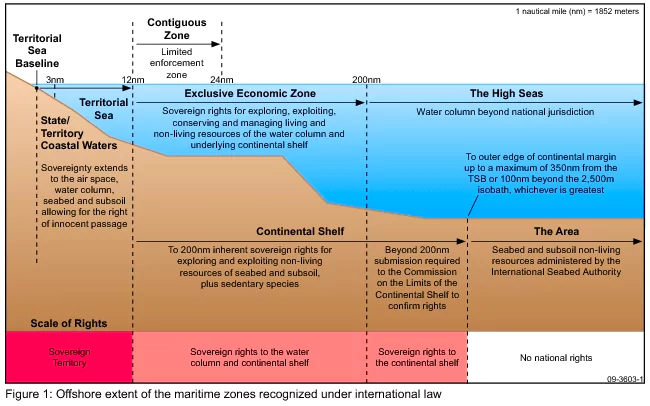Context
Recently, India has submitted an application to the International Seabed Authority (ISBA) seeking permission to explore the Afanasy Nikitin Seamount (AN Seamount) in the Indian Ocean.
Sensing China threat, India joins Sri Lanka in Race for Seabed Mining; Applies for Exploration Rights – Afanasy Nikitin Seamount
- Concerns Over Chinese Activities: India’s application is aimed at safeguarding its interests against the backdrop of escalating Chinese presence in the region and potential future ramifications.
- Safeguarding India’s Interests Competition from Sri Lanka: Sri Lanka’s application for an extended continental shelf claim of up to 500 nautical miles may pose competition for India’s exploration interests (India staked a claim for its continental shelf up to 350 nautical miles from its border).
Afanasy Nikitin Seamount
- It is a structural feature (400 km-long and 150 km wide) in the Central Indian Basin, located about 3,000 km away from India’s coast.
- Cobalt & other Mineral Deposits: It has Significant deposits of cobalt, nickel, manganese, and copper, situated within the Central Indian Basin.
|
- Exploration Application for the Carlsberg Ridge: India has also sought authorization to explore Carlsberg Ridge in the Central Indian Ocean to investigate for polymetallic sulphides (which are large smoking mounds near hydrothermal vents that are reportedly rich in copper, zinc, gold and silver).
Seabed Mining
- Seabed Mining is the extraction process that involves retrieving submerged minerals and resources like manganese nodules, seafloor massive sulfides, and cobalt crusts from the ocean floor, achieved through methods such as dredging sand or lifting materials in various ways.
Exploration Rights Over Open Ocean
These rights are specific to areas part of the open Ocean.
- Regulatory Framework for Exploration Exploration licenses for extraction activities in the open ocean must be obtained from the International Seabed Authority (ISBA), as no country can assert sovereignty over these areas.
Open Ocean
- Open ocean means the air, surface, and seabed where no country can claim sovereignty.
- Around 60% of the world’s seas are open oceans.
- Rich in a variety of mineral wealth, the costs and challenges of extraction are prohibitive.
|
Impediment to India’s Exploration Ambitions
- India’s exploration plans could be influenced by the decisions of the Commission on the Limits of the Continental Shelf (which decides on the limits of the country’s continental shelf), particularly concerning continental shelf claims in the Bay of Bengal.
The United Nations Convention on the Law of the Sea (UNCLOS)
- Aim: The United Nations Convention on the Law of the Sea (UNCLOS) lays down a comprehensive regime of law and order in the world’s oceans and seas, establishing rules governing all uses of the oceans and their resources.
- Adopted in 1982.
- Functions:
-
- It divides marine areas into five main zones: the High Seas, Exclusive Economic Zone (EEZ), Contiguous Zone, Territorial Sea, and Internal Waters.
- It serves as the framework for offshore governance among coastal nations and seafarers.
- It offers detailed instructions on each state’s rights and obligations inside the five concentric zones.
- Under the treaty,
- The seabed and its mineral resources are considered the “common heritage of mankind” .
- They must be managed in a way that protects the interests of humanity through the sharing of economic benefits, support for marine scientific research, and protecting marine environments.

International Seabed Authority (ISA)
- Established in: 1994.
- Headquarters: Kingston, Jamaica.
- Function:
- To regulate mining and related activities in the international seabed beyond national jurisdiction, an area that includes most of the world’s oceans.
- The ISA came into existence upon the entry into force of the 1982 United Nations Convention on the Law of the Sea.
Commission on the Limits of the Continental Shelf
- Aims: To facilitate the implementation of the United Nations Convention on the Law of the Sea regarding establishing the outer limits of the continental shelf.
- Function:
- To delineate the outer limits of the continental shelf extending beyond 200 nautical miles from baselines.
- It is empowered to issue binding recommendations to coastal States concerning establishing these limits.
|
Geoeconomic and Geostrategic Significance of Deep Sea Mining in Central Indian Ocean Basin
-
China’s Assertiveness in the Region:
- China’s presence over the region claims the rights of territorial sovereignty that could extend its influence in the South China Sea, the East China Sea, and the Indian Ocean.
- Therefore it’s very important to protect & explore the Oceanic Ecosystem for All.
-
Strategic Influence Concerns:
- There is apprehension that countries exploring deep sea mining beyond their Exclusive Economic Zones (EEZ) will gain strategic influence in the region.
-
Political Motivations of the Country’s:
- Deep-sea mining holds not only economic value but also serves as a political tool, enabling access and monitoring of international or disputed waters.
- Particularly to reduce dependence on China for rare earth elements (REEs) crucial for high-tech electronics manufacturing.
-
Access to Open Ocean based on the Exploration Rights:
- It will make each nation a level playing field over the region to pop up their economy &
- Availability of Rare Earth Elements (REEs) in PMNs is critical for each country’s ambitions in manufacturing strategic defense systems, semiconductors, and clean energy technologies.
-
Prioritization of Deep Sea Exploration by India:
- It is seen as an unavoidable necessity for India from a geo-economic perspective.
- India must persist in scientific research, conduct comprehensive environmental assessments, and enhance its capacity and capabilities to facilitate further exploration of deep ocean resources.
- For Example: Projected Samudrayaan Mission of India & Matasya 6000 for Deep sea mission.
Also Read: PM Modi And Israeli PM Netanyahu Discuss Maritime Safety
![]() 27 Mar 2024
27 Mar 2024
